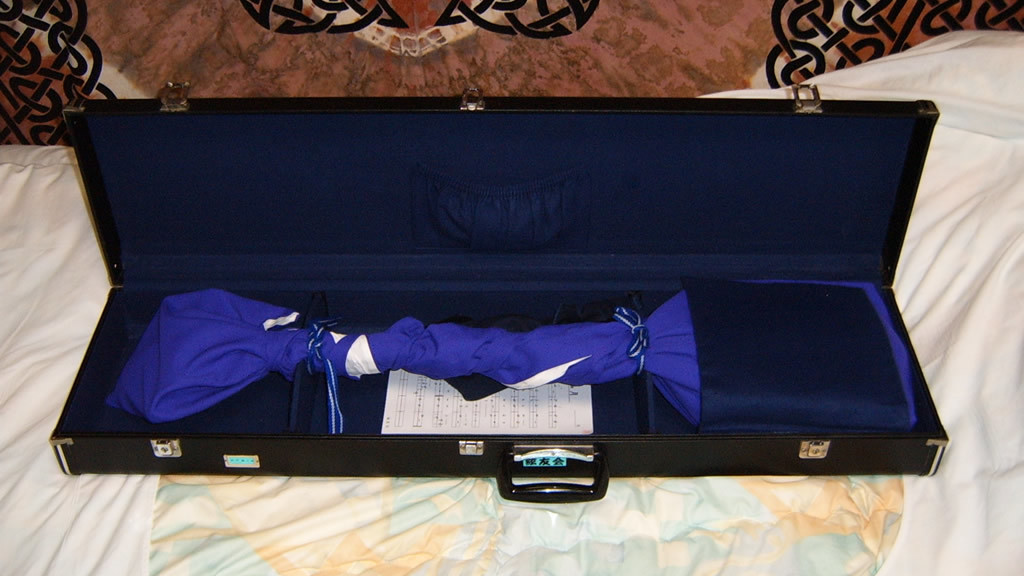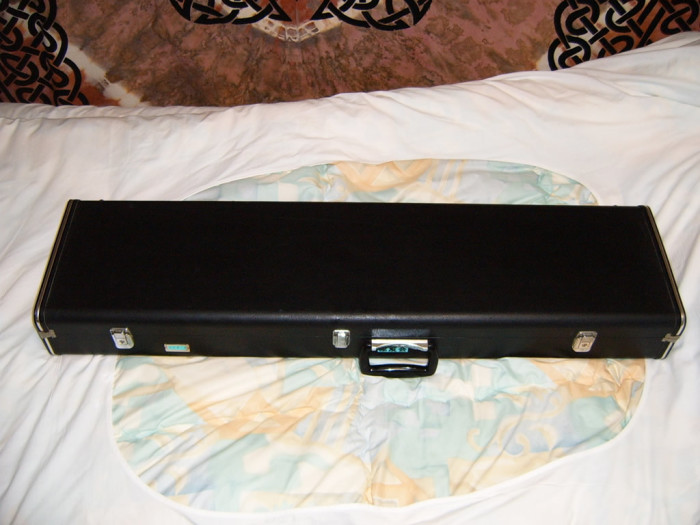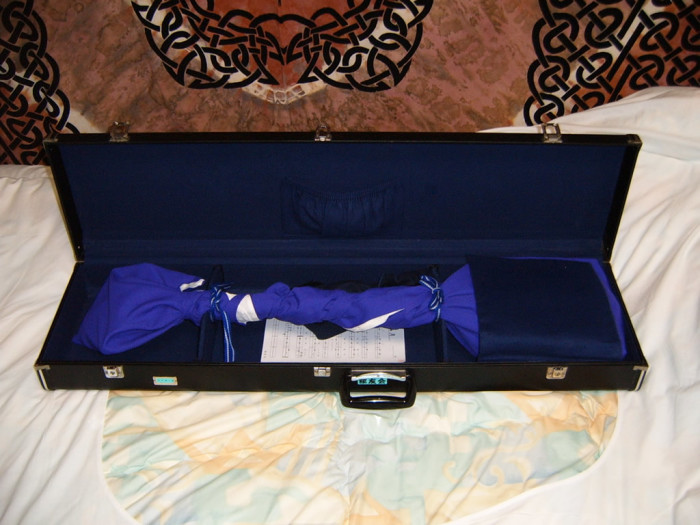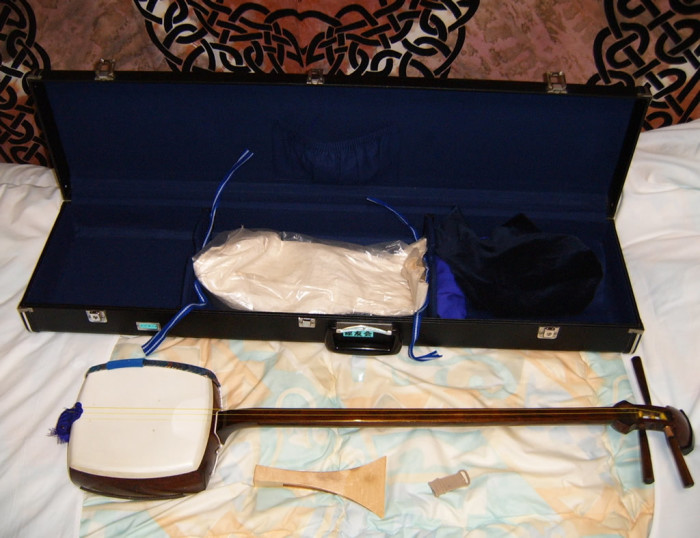It’s hard to believe it’s already October 26th. Has it really been three days since I last updated? Today was my inaugural shamisen lesson with Ishikawa-sensei. Lately I have gotten some requests that I take more pictures of my activities. You must understand that I’m walking a fine line between “adequate documentation” and “obnoxious foreigner with a camera.” To this end, I darest not disrespect Ishikawa-sensei by bring a camera today. To do so on the first lesson would be idiotic, perhaps after a few months and some steady gains, but initially, no way. However, rather than leave you out in the cold, my trusty sidekick Doctor-in-Training Walter was able to come up with a picture of my teacher.
A true journal records the good alongside the bad, and doesn’t leave bits out just because they might embarrass the author. I try my best to tell you about my life as it happens over here, and don’t embellish or censor my adventures, goodness knows some of them are ridiculous enough already. Therefore, I can tell you without embarrassment that at the beginning of my first lesson, having seated myself in front of Ishikawa-sensei, I proceeded to spill my green tea on his carpet. Choosing this sort of action by which to introduce myself would generally be considered “not very awesome.” That’s something I don’t think I’m going to live down any time soon… such is life.
My nervousness-induced clumsiness aside, the rest of the lesson went exceptionally well. Due to the complexities of colloquial speech, compounded by a regional accent, I can understand perhaps at best 5% of what Ishikawa-sensei actually says. However, we are able to communicate far more effectively through gestures and the lesson, while not lucid, was productive.
We covered how to pack and unpack the shamisen and how to tune it. Then he instructed me in the reading of shamisen sheet music(not exactly sharps and flats folks). Lastly, I repeatedly massacred a short 16 note tune while he slowly honed my posture and the mechanics of my playing.
I knew the shamisen was an exceptionally challenging instrument ahead of time, but having actually played one and in turn been instructed in, and shown, how to play one skillfully, I can tell you that every single part of this instrument exists solely to make it more difficult to play.
For starters, there are no frets on the neck. For a beginner, learning the places to use your fingers for creating notes without the tactile and visual feedback frets give you is nigh impossible… Furthermore, as one progresses in skill the note positions themselves become less and less fixed, as the musician is encouraged to coax out the particular feel of the song on his own. The end result is a highly dynamic and flexible range of notes, which also means a giant learning curve.
How about some pictures? This is the badass case it travels in.
You could hide a very nice submachine gun in there, were you a spy or an action hero. Open the case and you can see how extensively padded and protected it is.
Virtually every surface of the shamisen can be damaged by the oils in one’s skin, so it must be fully wiped down after every use and then stored in those airtight wrappings. Finally, this is the shamisen itself.
The wooden object at the bottom is the bachi, used to pluck the strings, and the small grey object to the right of that is the yubi-kake, which slides over your thumb and index finger to facilitate sliding along the neck whilst playing.
I played a fair amount with Ishikawa-sensei and then played for another half hour or so tonight before my right hand began to cramp from holding the bachi(you employ a very odd grip). The dorm rooms here in the AP Houses are heavily sound-proofed, but I fear I’ll have to find someplace else to practice. Shamisen are loud, extremely loud. I can play it “softly” but that’s still not all that soft, and it prevents me from practicing the correct strength and form for plucking the strings with the bachi. If I played it like it’s meant to be played, you’d be able to hear it all up and down the hall. Frankly, if I could play a pleasant melody, I don’t think anyone would care. But right now I doubt anyone wants to hear me playing the same 8 notes over and over, and playing them badly at that!
Lastly, I should tell you about the shamisen Ishikawa-sensei lent me. Shamisen, at the beginner level, command upwards of $1,500. This can easily reach the $7,000 mark and beyond for a professional concert shamisen. Generally a dedicated player would own several different ones, which would all fall in the $3-4,000 range. There are 3 types of material stretched over the front and back of the box(the white material in the picture). Plastic is cheap with very poor sound quality and is essentially detested by all regular players. Dog skin, taken from the soft skin of the lower belly, is the standard material used – one dog providing enough skin for one shamisen. Lastly, for the super top models, cat skins are employed. It usually takes 3 or 4 cats to make one shamisen since their corresponding belly areas are going to be smaller. For whatever reason though cat skin ages much faster than dog skin, and must be replaced quite often(every 2 years or so). As a result, the vast majority of shamisen are dog skin, as is mine.
That’s about all the shamisen info I’ve got for you tonight. I’m pretty worn out and ready to head to bed. Tomorrow morning Prof. Amartya Sen, Nobel Laureate in Economics 1998 and professor at Harvard, is visiting APU to lecture on “Reason, Discourse and Capability – Significance for the Asia Pacific.” To be honest I’ve never heard of this person before in my life, but APU is rolling out the red carpet for it’s first Nobel Prize-winning speaker so I’ll let you know how it goes…




